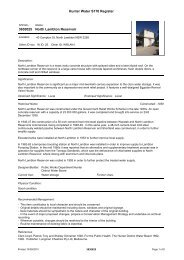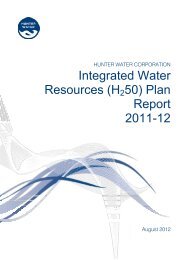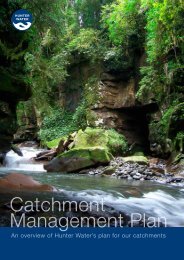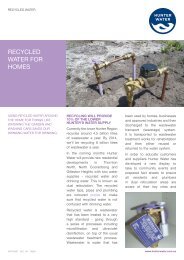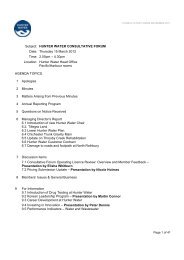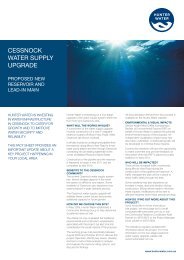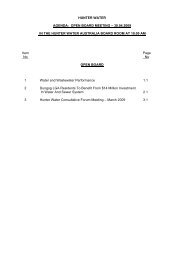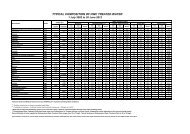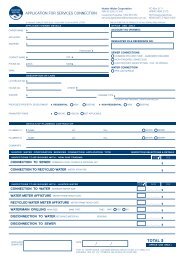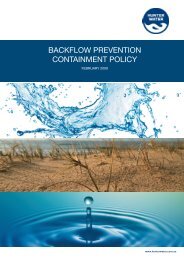Water Kit - Hunter Water
Water Kit - Hunter Water
Water Kit - Hunter Water
You also want an ePaper? Increase the reach of your titles
YUMPU automatically turns print PDFs into web optimized ePapers that Google loves.
3.3 raymond terrace WWTW<br />
Raymond Terrace WWTW<br />
Raymond Terrace WWTW serves about<br />
25,000 people in Raymond Terrace and<br />
Medowie.<br />
Control and monitoring<br />
The entire wastewater treatment process is<br />
automatically controlled by a series of<br />
computers that are linked to <strong>Hunter</strong> <strong>Water</strong>’s<br />
main computer system in Newcastle.<br />
Department of Environment and<br />
Conservation licence parameters. <strong>Hunter</strong><br />
<strong>Water</strong> also submits an annual report to<br />
this department to confirm that the facility<br />
has been operating within its licence.<br />
The upgraded Raymond Terrace WWTW<br />
The new Inlet Works is completely covered<br />
to control odour<br />
The original facilities were constructed<br />
in 1980. An upgrade was carried out to<br />
improve the quality of effluent produced<br />
at the facility and cater for the area’s<br />
population growth. To plan for this<br />
upgrade an Environmental Impact<br />
Statement was prepared and publicly<br />
exhibited, with approval for the upgrade<br />
granted by the state government.<br />
The upgraded Raymond Terrace WWTW<br />
is capable of treating an average flow<br />
of over 6.5 million litres per day, with<br />
the capacity to serve a population of<br />
approximately 29,500 people. Provision<br />
has been made in the design of the plant<br />
to allow for an upgrade to 35,000 people<br />
if required.<br />
Benefits of the Raymond Terrace<br />
WWTWThe Raymond Terrace<br />
WWTW was designed and built to<br />
treat wastewater to a high standard<br />
and to have a minimal impact on the<br />
environment. This has been achieved<br />
by collecting wastewater from houses,<br />
business and industry via pipes and<br />
pumping stations, and directing it to the<br />
WWTW. The wastewater is treated to<br />
a high standard, disinfected and then<br />
discharged into Grahamstown Drain<br />
which then flows into Windeyers Creek<br />
and the <strong>Hunter</strong> River.<br />
Where it is economically viable, treated<br />
wastewater is recycled and used in<br />
activities such as the irrigation of golf<br />
courses and for industrial purposes. The<br />
collected residual solids (or dewatered<br />
sludge) are called ‘biosolids’ and are<br />
reused for activities such as minesite<br />
rehabilitation.<br />
To ensure that the facility is operating<br />
efficiently, sampling and testing are<br />
conducted on the holding tanks and<br />
discharge waters. The results are<br />
analysed to ensure the treatment<br />
processes continue to meet the<br />
Wastewater treatment at Raymond Terrace<br />
Inlet Works<br />
The inlet works receive wastewater through four sewer mains. The inlet works<br />
house the step screens and the grit tank.This area is covered and kept under<br />
constant vacuum to contain odours, which are then passed through a soilbed filter.<br />
Soilbed Filter<br />
The organic soilbed filter consists of layers of gravel, soil, peat and bark chips. This<br />
soilbed allows the growth of natural bacteria which breakdown and disperse odours.<br />
Step Screen<br />
Large objects and solids present in the wastewater are removed using two fine<br />
automatic step screens. The bars on the two screens are 5mm apart and can treat<br />
up to 1000 litres per second. The screenings are washed and dewatered and then<br />
disposed to landfill<br />
<strong>Water</strong> kit . ssS . 001 . april 2010<br />
7




